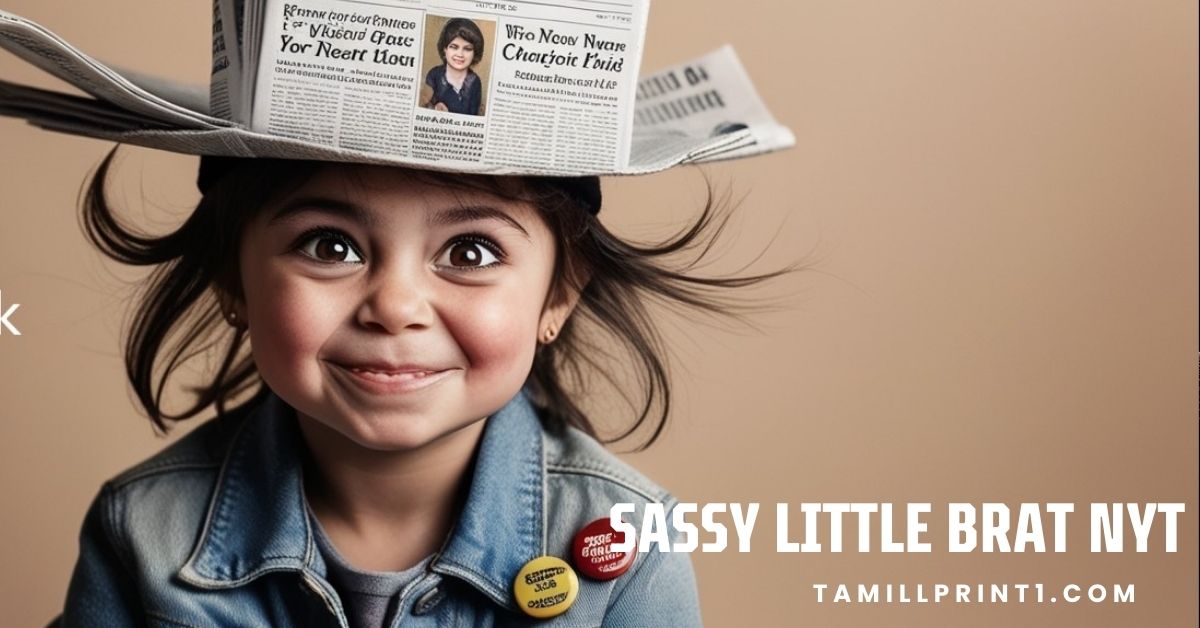The phrase Sassy Little Brat NYT has recently gained attention, sparking curiosity about its meaning, origin, and relevance. Whether it’s used to describe a feisty personality, a playful insult, or a cultural reference, this term resonates with many. But what exactly does it mean, and why has it become so popular? In this article, we will explore the origins, interpretations, and implications of the phrase Sassy Little Brat NYT, offering insights beyond what is already available online.
What Does Sassy Little Brat NYT Mean?
A sassy little brat is someone who is outspoken, bold, and slightly mischievous. This term is often used playfully to describe someone with a defiant but charming attitude. The word “sassy” conveys confidence, quick wit, and a touch of rebellion, while “brat” implies a mischievous or stubborn nature.
In many cases, this phrase is used humorously rather than as an insult. It can describe a child, a playful adult, or even a fictional character who exudes confidence and feistiness. The term may have gained traction in pop culture, social media, and even in media references such as the New York Times (NYT), making it a buzzworthy phrase.

The Origins of Sassy Little Brat NYT
While the exact origin of Sassy Little Brat NYT remains uncertain, it is clear that both “sassy” and “brat” have been in use for a long time:
- Sassy originated in the 19th century from “saucy,” meaning impudent or lively.
- Brat has been used for centuries to describe a mischievous or spoiled child.
- The combination of these words likely evolved through pop culture, television, movies, and social media.
The “NYT” (New York Times) part of the phrase suggests that it may have been referenced in an article, review, or media discussion that gained traction online. Some internet trends originate from misinterpretations or humorous contexts, leading to viral popularity.
Why Has Sassy Little Brat NYT Become So Popular?
Several factors contribute to the rise of Sassy Little Brat NYT:
1. Social Media Influence
Memes, TikTok, and Twitter have played a massive role in making quirky phrases go viral. Sassy personalities are celebrated online, making terms like “sassy little brat” popular in humorous and playful contexts.
Also Read: ShortEngine.com: Your Ultimate Tech News Hub
2. Pop Culture References
Many TV shows, movies, and books feature characters that fit the sassy little brat description. Think of beloved, bold characters in movies like Matilda or Wednesday Addams, who challenge authority but remain endearing.
3. Playful Insults & Endearing Terms
Unlike offensive insults, “sassy little brat” often conveys affection and admiration, making it widely used among friends, parents, and partners in a lighthearted way.
4. Possible Media Coverage
If the phrase “sassy little brat” has been mentioned in a New York Times (NYT) article, book review, or opinion piece, it could have further propelled its recognition.
The Psychology Behind a “Sassy Little Brat”
Why do people love or identify with the sassy little brat personality? Here are a few psychological insights:
- Confidence is Attractive: People admire those who can stand up for themselves in a witty or clever way.
- Rebellion is Relatable: Many individuals, especially younger audiences, connect with characters or people who challenge authority in a playful way.
- Humor & Charm: Sassiness is often linked with humor, making people laugh rather than feel offended.
- Breaking Social Norms: Feisty personalities push against traditional roles, making them more intriguing and appealing.
How Sassy Little Brat NYT Relates to Modern Culture
The phrase Sassy Little Brat NYT isn’t just about attitude—it reflects shifting cultural values. In today’s world:
Also Read: Investiit.com Tips: Smart Strategies for Successful Investing
- Boldness is Celebrated: Women, children, and even men are encouraged to be confident, speak their minds, and stand their ground.
- Personality Over Politeness: While manners are important, individuality and expressing emotions are seen as strengths.
- Social Media Loves Drama & Wit: Quick comebacks, sarcasm, and wit often go viral, making sassiness an admired trait.
How to Embrace Your Inner “Sassy Little Brat”
If you relate to the “sassy little brat” persona, here are some ways to embrace it positively:
- Be Confident: Speak your mind, but with kindness.
- Stay Playful: Keep it lighthearted, not mean-spirited.
- Use Humor: Witty comebacks can be fun, but avoid offending others.
- Know When to Dial It Back: Being sassy is great, but respect is key in serious situations.
Common Misconceptions About Sassy Little Brat NYT
Despite its popularity, some misunderstand the phrase. Here are some common myths:
- Myth 1: It’s Always an Insult – While “brat” can sound negative, the phrase is often used playfully.
- Myth 2: Only Children Can Be Sassy Brats – Adults can also display sassiness in a charming way.
- Myth 3: Sassiness Means Rudeness – Sass is about confidence and wit, not necessarily disrespect.
Also read: Milwaukee Bucks vs Pacers Match Player Stats: In-Depth Analysis & Insights
FAQs About Sassy Little Brat NYT
What does Sassy Little Brat NYT mean?
It describes someone who is bold, feisty, and confident, often in a humorous or playful way. The “NYT” part might relate to a media reference.
Why is Sassy Little Brat NYT trending?
The phrase has gained popularity due to social media, pop culture, and possible media mentions.
Is “sassy little brat” an insult?
Not necessarily. It can be used playfully to describe a confident, witty person with attitude.
Did Sassy Little Brat NYT appear in a New York Times article?
There may be references in articles or pop culture discussions, which helped boost its popularity.
How can I use “sassy little brat” in a sentence?
- “My little sister is such a sassy little brat, but I love her confidence!”
- “That character in the movie was a total sassy little brat—so funny!”
Conclusion
The phrase Sassy Little Brat NYT captures a bold and playful attitude that resonates with many. Whether it’s used as a lighthearted tease, a cultural reference, or a personality description, its appeal lies in its mix of confidence, humor, and charm. As pop culture continues to celebrate strong and witty personalities, this phrase will likely remain relevant in conversations, social media, and entertainment.
Understanding the deeper meaning behind Sassy Little Brat NYT allows us to appreciate its role in modern language and culture. So, whether you’re embracing your own sassiness or simply enjoying the phrase’s playful nature, it’s clear that a sassy little brat will always make an impression!







